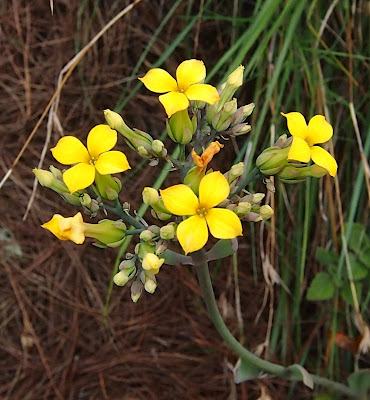Kalanchoe spathulata, a native Philippine succulent
As one might expect, the succulent flora of tropical regions are rather depauperate compared to those in more arid climates further north or south of the equator. However, families of primarily succulent plants persist even in the tropics, notably the Crassulaceae, which encompasses well-known succulent genera such as Crassula and Echeveria. In the Philippines, two genera are present- Kalanchoe and Sedum. The former was very poorly understood until quite recently, and many thought that plants found in a wild state in parts of the archipelago were escapees from cultivation, notwithstanding the fact that the plants seen farthest from human settlements all bore yellow flowers and thus lending suspicion that all were from the same species. Perhaps the most popular species in cultivation, K. blossfeldiana, has not been found in the wild despite its prevalence in gardens around towns. Three Kalanchoe species that are not native to the Philippines which have established feral populations are K. daigremontiana, K. tubiflora, and K. pinnata, known in Tagalog as 'kataka-taka' and figures in folk medicines. The first two are found only around cities and towns, their propensity to produce massive numbers of plantlets on the leaf margins no doubt contributing to the proliferation. Meanwhile, the yellow-flowered kalanchoes seen in many remote locations in the Philippines were construed to be K. integra, now regarded a synonym of K. spathulata. This species is the most widespread of Asian kalanchoes and is represented by a number of varieties. The taxon, however, is very poorly seen in cultivation compared to exotic species mentioned above. If plants much more common in cultivation won't form populations in far-flung areas, then it defies logic why a species seldom seen even in large gardens would. Kalanchoe spathulata is a true Philippine species.
 |
Following the 2003 paper by Hideaki Ohba (Taxonomic Studies on the Asian Species of the Genus Kalanchoe (Crassulaceae) 1. Kalanchoe spathulata and Its Allied Species), two subspecies of K. spathulata are recognized from the Philippines, the nominate K. spathulata var. spathulata and K. spathulata var. baguioensis. Both carry yellow flowers, but var. baguioensis differs in being a hairy plant, with indumentum being present on the upper parts of the stem and inflorescences, as well as on the calyces and corollas. The plants shown here is from var. spathulata, a seemingly widespread taxon found from about sea level to ca. 1800 m asl. Botanical collections have been made from Ilocos Norte, Benguet, Bataan, and Batangas on Luzon, and Langen Island near Palawan. A 1953 collection from Mountain Province may belong to this subspecies. Additional populations have been detected, through photographs, from Sagada, Zambales, and the island of Pandan off Mindoro. On the other hand, var. baguioensis has been recorded from Benguet, Baguio, and Bataan. Of note here is the fact that both subspecies were recorded from both Benguet and Bataan; on Bataan, both plants were collected on Mariveles. Botanical surveys should determine if the two subspecies there occupy differing niches even on the same locality, and if hybridization events occur if they do.
 |
| Specimen with prominent anthocyanin pigmentation. Not all plants bear red-tinged leaves, even if growing in the same conditions as these sun-stressed plants. |
 |
| Kalanchoe spathulata var. spathulata growing with a species of Rubus on an outcrop at about 1800 m. |
 |
| Kalanchoe spathulata var. spathulata on a rock ledge, ca. 1700 m asl. |
I have been keeping the high altitude K. spathulata var. spathulata for seven years now but is a very, very slow-growing plant. One might think that the higher temperatures may be contributing to the pace of growth, but my observations from the field also suggest that even wild plants in subtropical temperatures grow and develop not much faster. Flowering from the wild has been observed by myself during the months of December and January.
H. Ohba's 2003 paper, referenced above, can be accessed here: http://www.jjbotany.com/pdf/JJB_078_247_256.pdf




Your blog is very amusing and informative. I do hiking a lot and encountered plants and tried to ID some using google lens and stumbled upon your blog.
ReplyDeleteSame here! I found out early on that observing plants in the wild give much more detail and information than if I were to find these on the web instead. Thanks for the kind words!
Delete